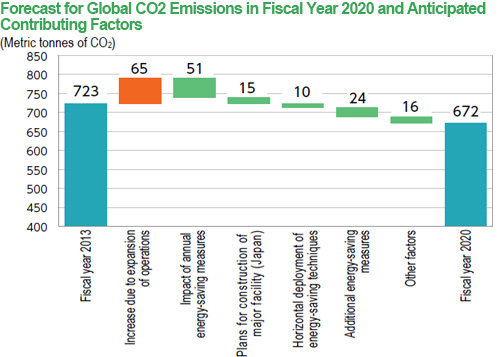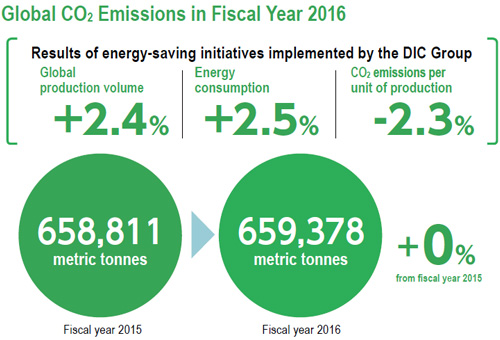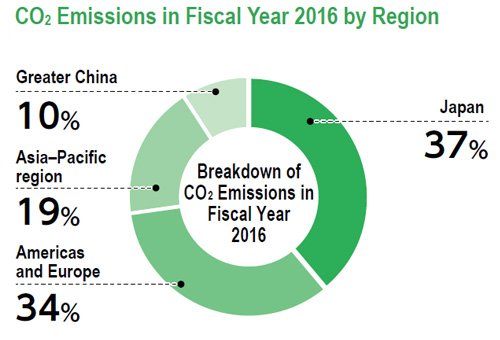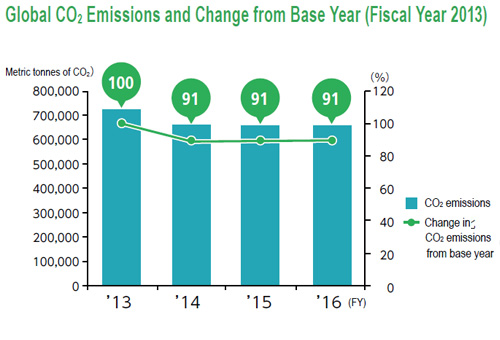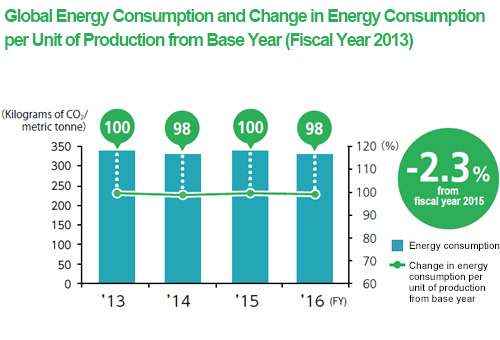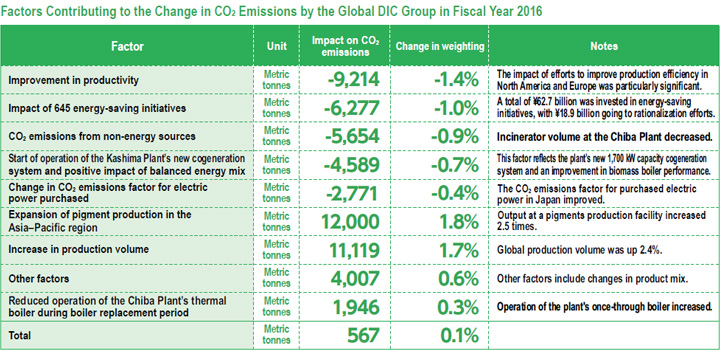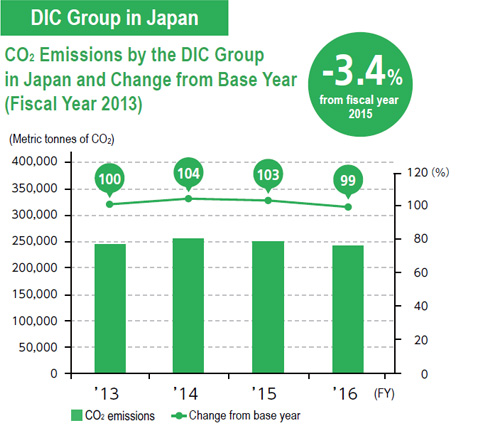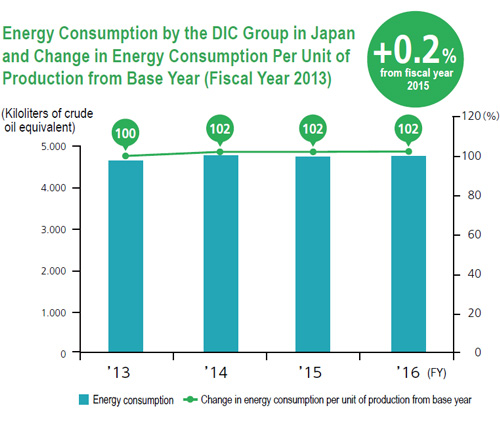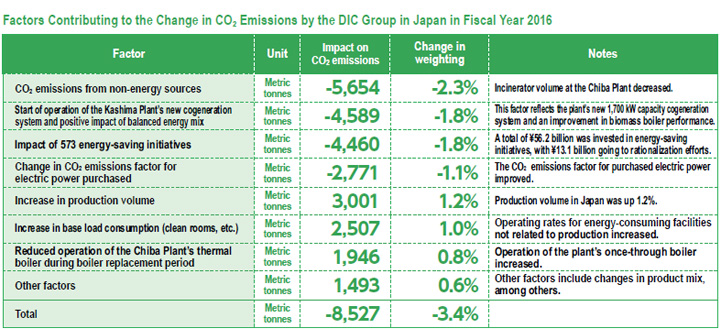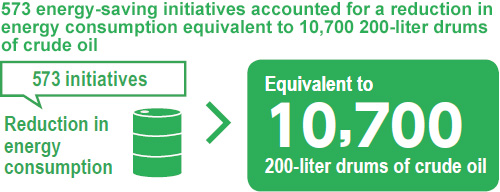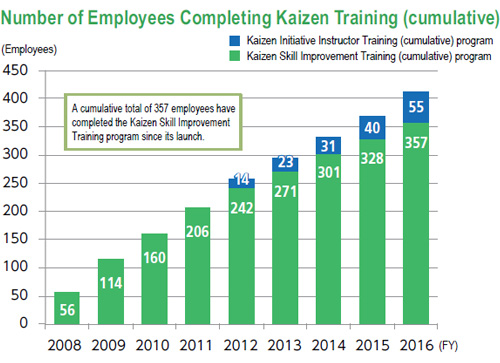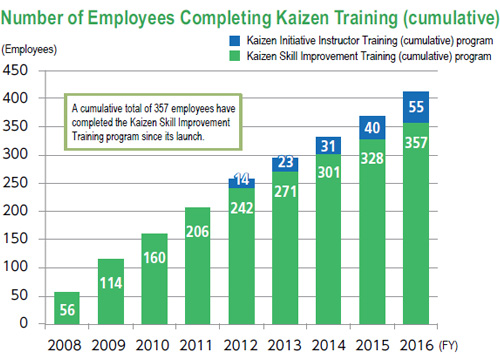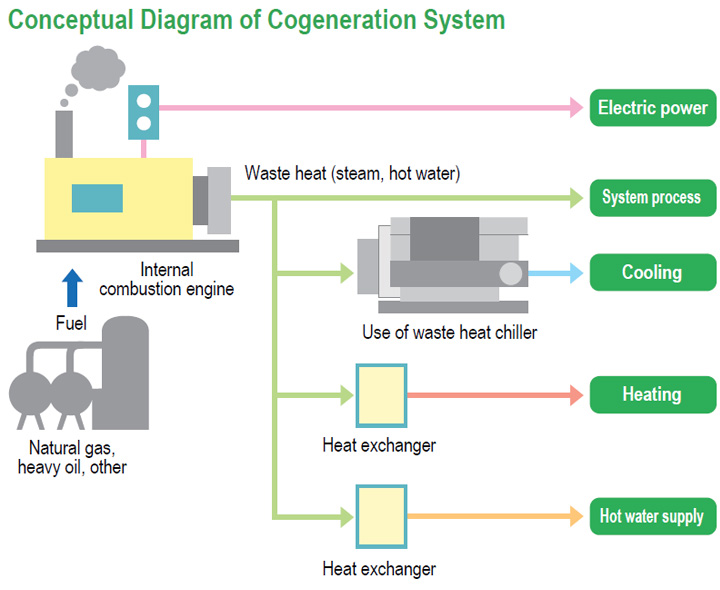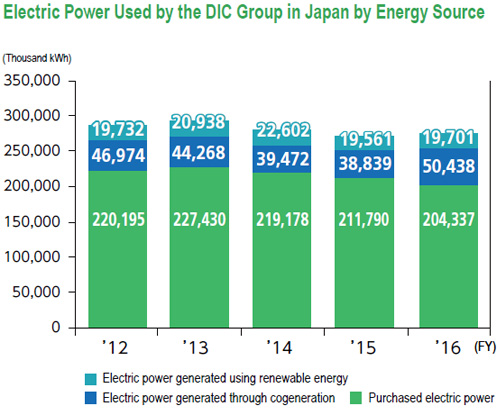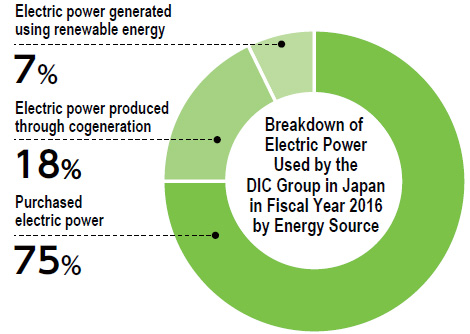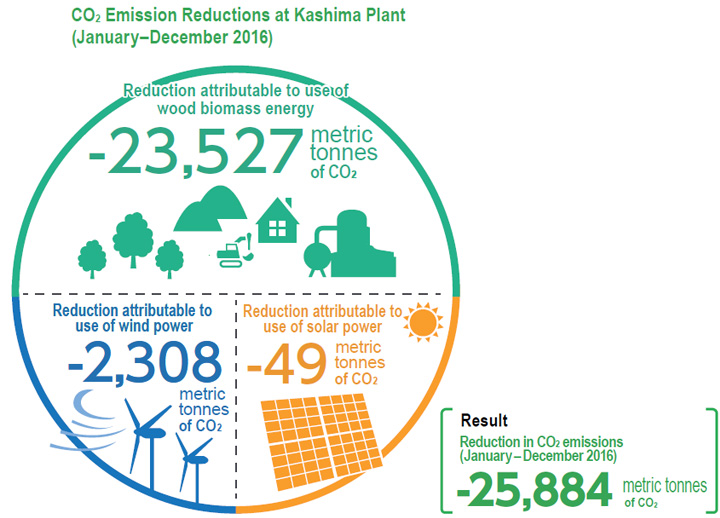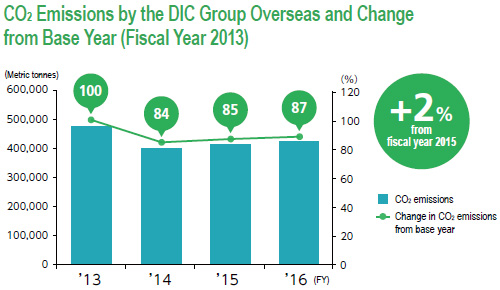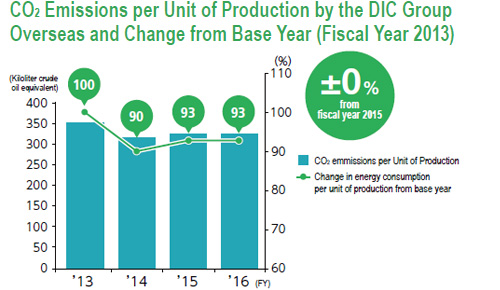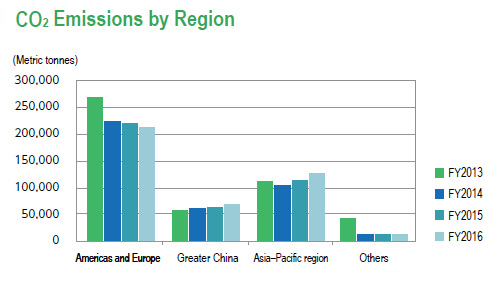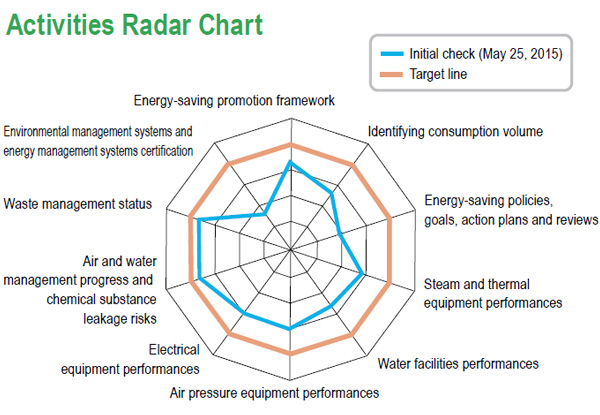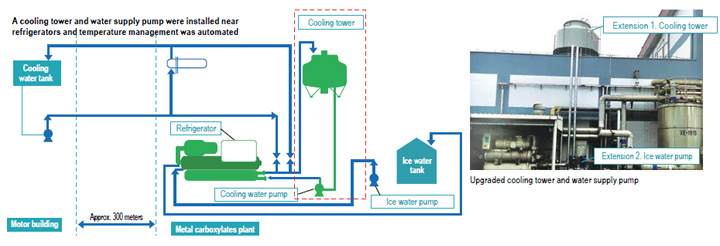Preventing Global Warming(2016)
Principal Initiatives in Fiscal Year 2016
-
Formulation of Medium-Term Target for Reducing CO₂ Emissions by Fiscal Year 2020
In October 2016, the Sustainability Committee, which is responsible for formulating the DIC Group’s annual sustainability policy and activity plans, approved a new medium-term target for the reduction of CO₂ emissions. In line with this target, the Group will work to achieve an average annual decrease of 1.0% with the aim of realizing a 7.0% reduction from the fiscal year 2013 level by fiscal year 2020.
-
Energy Consumption and CO₂ Emissions by the Global DIC Group
Despite to a 2.4% increase in production volume, energy consumption by DIC Group companies worldwide rose 2.5%, to the equivalent to 293,577 kiloliters of crude oil, compared with 286,392 kiloliters in fiscal year 2015, global CO₂ emissions remained essentially level at 659,378 metric tonnes, compared with 658,811 metric tonnes.
The DIC Group manufactures a wide variety of products at production facilities around the world, including printing inks, polymers, pigments, LCs, engineering plastics and compounds. Recent months have seen an increase in production of fine chemicals, which is energy intensive, and a corresponding decline in production of items that require comparatively little energy. Nonetheless, CO₂ emissions were on a par with the previous fiscal year. Factors behind this included the start of full-scale operation of a new cogeneration system at the Kashima Plant, efforts to achieve an appropriate balance of energy from renewable sources such as biomass boilers, wind power and solar power, and the implementation of 645 energy-saving initiatives. In contrast, CO₂ emissions per metric tonne of production ("CO₂ emissions per unit of production," Eexpressed in terms of kilograms of CO₂ per metric tonne of production) declined 2.3% in fiscal year 2016, to 338.0 kg/metric tonne, from 345.8 kg/metric tonne in fiscal year 2015, a decrease of 2.0% from fiscal year 2013, the Group’s current base year. The decline in CO₂ emissions per unit of production underscores the Group’s success in curbing emissions despite an increase in production. The Group will further roll out fuel conversion and high-efficiency equipment, as well as revamp processes and improve capacity utilization, at all of its production sites. -
Energy Consumption and CO₂ Emissions by the DIC Group in Japan
In fiscal year 2016, the DIC Group in Japan—encompassing the 54 sites of DIC Corporation and domestic DIC Group companies—reported a 1.2% increase in production volume from fiscal year 2015. Energy consumption by the DIC Group in Japan in fiscal year 2016 rose 1.4%, to the equivalent of 111,306 kiloliters of crude oil, from 109,798 kiloliters in fiscal year 2015, while energy consumption per unit of production—an indicator set forth in Japan’s Act on the Rational Use of Energy—was level at 4.77 GJ/metric tonne. In contrast, CO₂ emissions declined 3.4%, to 242,194 metric tonnes, from 250,720 metric tonnes in fiscal year 2015, while CO₂ emissions per unit of production, at 268.0 kg CO₂ equivalent, were down 4.5%, from 280.7 kg CO₂ in the previous period. The principal factors behind these decreases included the start of full-scale operation of a new cogeneration system with a 1,700 kW capacity at the Kashima Plant, one of the Group’s principal production facilities in Japan, efforts to achieve an appropriate balance of renewable energy sources (biomass boilers, wind power, solar power) and the implementation of 573 energy-saving initiatives.
-
Energy-Saving Initiatives by the DIC Group in Japan
All plants and R&D sites endeavor to conserve energy through the following initiatives to reduce base load energy consumption and by applying the PDCA cycle to improve the efficiency of production methods, thereby reducing energy used, as well as to shorten process times.
- Employ highly efficient lighting and air conditioning and measures to cut waste
- Introduce energy-saving controls on pumps and blowers
- Use more efficient compressors and implement measures to reduce pressure losses
- Measures to improve the power factors of electric equipment
- Adopt high coefficient of performance (COP) chillers and measures to prevent cold and hot water supply waste
- Reduce boiler fuel through the recovery of waste heat
- Ensure appropriate warming times and temperatures for raw materials
In fiscal year 2016, these initiatives reduced energy consumption by 83,000 GJ (2,140 metric tonnes carbon equivalent). This corresponds to 10,700 200-liter drums of crude oil, or 1.9% of total energy consumption by the DIC Group in Japan in the previous period. Going forward, the Group will continue to promote energy-saving measures, as well as to share best practices among sites. The Group will also reinforce operating manuals for key energy-consuming equipment, including boilers, chillers and compressors, to optimize performance, as well as step up the deployment of initiatives both in Japan and overseas.
Key Energy-Saving Initiatives Implemented by the DIC Group in Japan in Fiscal Year 2016
No Unit Energy-saving initiative Reduction in
annual energy
consumption (GJ)Reduction in
CO₂ emissions
(metric tonnes)1 Chiba Plant Reduced steam losses by introducing direct reception from tanker trucks delivering pigments for printing inks 3,624 218 2 Yokkaichi Plant Shifted to use of one brine freezing unit 2,317 118 3 Utsunomiya Plant Shortened operating times of cooling water pumps 2,058 106 4 Komaki Plant Reduced steam used by repairing steam line 2,216 113 5 Tatebayashi Plant Optimized capacity of cooling water pumps 2,432 125 6 Tatebayashi Plant Reduced energy consumption by adjusting operation of water cooling–related equipment 1,955 100 7 KJ Chemicals Corporation Reduced costs associated with dynamic temperature of N,N-Dimethyl acrylamide (DMAA) 2,922 178 8 Hokuriku Plant Reduced operating times for nitrogen generation devices by 95% 1,262 82 9 Gunma Plant Changed electric heating temperature settings and shut equipment off when not in use 1,461 75 10 Yokkaichi Plant Set standards for waste heat recovery 1,390 69 11 Kansai Plant Switched from kerosene-powered to flue gas recirculation boilers 732 66 12 Kashima Plant Reduced energy consumption by improving operation of steam traps 1,200 62 13 Sakai Plant Reduced consumption of town gas by optimizing the temperature of water supplied to deodorization furnace 1,222 62 14 KJ Chemicals Corporation Reduced costs associated with dynamic temperature of acryloyl morpholine (ACMO) 958 59 15 Sakai Plant Upgraded to EHP air conditioning systems on the second and third floors of the No. 1 building 1,147 58 16 Hokuriku Plant Reduced energy consumption by repairing air valves to prevent air leaks 889 58 Subtotal (17 initiatives) 27,785 1,549 Others (556 initiatives) 54,161 2,912 Total (573 initiatives) 81,946 4,461 Improving Yields by Expanding Use of System to Enhance the Visibility of Energy Consumption
With the aim of optimizing energy use on an individual facility basis, DIC developed a system that measures, monitors and verifies waste and irregularities in use in real-time, thereby enhancing the visibility of energy consumption. Initially installed at the Hokuriku Plant in 2012, the system—which won the ECCJ Chairman’s Prize at Japan’s 2012 Energy Conservation Grand Prize awards, sponsored by the Energy Conservation Center, Japan (ECCJ)—has since been rolled out at DIC sites across Japan. In fiscal year 2014, the system was installed at the Komaki Plant. In addition, a system to enhance visibility that also analyzes energy consumption during different production processes was installed on the V, C and B production floors of the Chiba, Kashima and Sakai plants, respectively, to reproduce optimum yields for materials inputs. In fiscal year 2016, DIC installed a more advanced version of the system at the Yokkaichi Plant.
One outcome of efforts to enhance the visibility of energy consumption was an increase in the number of categories of Scope 3*, in which DIC reports indirect emissions of CO₂, from one ("upstream transportation and distribution") in fiscal year 2012 to six (including "capital goods," "waste generated in operations" and "business travel") in fiscal year 2013.- Scope 3 is the Greenhouse Gas Protocol’s standard for calculating indirect greenhouse gas emissions resulting from production, transport, business travel and commuting, among others, across entire supply chains.
Reducing Energy Consumption and Enhancing Product Quality through Kaizen Skill Improvement Training
Having recognized that enhancing the awareness of employees in production and providing them with the tools to continuously improve their work are crucial to strengthening front-line capabilities, in 2008 DIC began offering the Kaizen Skill Improvement Training program. This program—which is structured around four themes, namely, reducing energy consumption, increasing yields, enhancing product quality and rationalizing operation—seeks to foster professionals who can identify and resolve issues on their own initiative. Participants spend one year participating in initiatives aimed at improving quality control methods and the following year putting their findings into practice. Each December, achievements are presented at a briefing attended by pertinent plant general managers and directors.
Since 2012, DIC has also offered the Kaizen Initiative Instructor Training program, designed to equip employees who have completed the Kaizen Skill Improvement Training program with the leadership and educational skills necessary to serve as instructors for the program. As of the end of fiscal year 2016, a cumulative total of 412 employees from DIC sites in Japan had completed this program, with approximately 10% subsequently going on to earn accreditation as program instructors, adding momentum to energy-saving and other initiatives. -
Increasing Independent Electric Power Generation through Cogeneration and the Use of Renewable Energy
Increasing Cogeneration System–Based Independent Electric Power Generation
With the aim of increasing energy efficiency, and as a precaution against natural disasters, the DIC Group in Japan is advancing the systematic adoption of cogeneration and the use of renewable energy, that is, energy from sources that are naturally replenished. Cogeneration systems burn fuel to drive turbines, facilitating the production of electric power and the recovery and reuse of waste heat (steam and hot water), thereby improving energy efficiency.
With cogeneration systems already in operation at five domestic plants (Chiba, Shiga, Saitama, Gunma and Tokyo), in December 2015 DIC installed a natural gas turbine–powered cogeneration system with a capacity of 1,700 kW at its Kashima Plant. These systems operated at full capacity for all of fiscal year 2016, contributing to the reduction of CO₂ emissions. In April 2017, the Company replaced the existing cogeneration system at its Chiba Plant, which had a capacity of 6,000 kW, with a new high-efficiency 3,800 kW capacity system, with the aim of optimizing capacity and reducing energy consumption. As of December 2016, the total combined maximum generating capacity of the Group’s cogeneration systems in Japan was 21,000 kW. Electric power produced through cogeneration in fiscal year 2016 amounted to 50,440,000 kW, equivalent to 18.4% of the electric power consumed by the DIC Group in Japan during the period.Using Renewable Energy
In Japan, the DIC Group actively promotes the use of energy from renewable sources at suitable sites. The biomass boiler at the Kashima Plant (generating capacity: 4,000 kW and 30 tons of steam per hour) contributes significantly to this effort. DIC focuses on improving the quality of wood chips used as boiler fuel, which influences operating rates, as well as on enhancing maintenance procedures. By combining this boiler with two wind power generation facilities (each with a generating capacity of 2,300 kW) and a solar power generation system (100 kW), the Group aims to achieve an optimal power mix of purchased electric power, electric power produced through cogeneration systems and electric power generated using renewable energy.
In fiscal year 2016, the Kashima Plant’s biomass boiler’s operating rates were reduced owing to maintenance, resulting in a 15.5% decline in renewable energy usage volume from the previous fiscal year, to 10,579 kiloliters (9.5% of the DIC Group’s energy consumption in Japan). As a consequence, the positive impact of the use of renewable energy on the Group’s CO₂ emissions in fiscal year 2016 was 25,884 metric tonnes. The plant is currently in the process of building a 1,600 kW megasolar system (comprising 5,588 278-watt solar panels, with a surface area of 13,722m²), which is scheduled to begin operating in January 2018. In December 2017, DIC also plans to install a biomass boiler at the Hokuriku Plant in Ishikawa Prefecture, in line with its ongoing commitment to achieving an optimal power mix while at the same time reducing emissions of CO₂.
In fiscal year 2016, electric power generated in Japan using cogeneration systems and other independent means amounted to 70,140,000 kW, an increase of 9.0% from fiscal year 2015, representing 25.6% of total energy consumed by the DIC Group in Japan.Reducing Energy Consumption at the DIC Group’s Global Corporate Headquarters Building
In May 2015, DIC completed the reconstruction of its corporate headquarters, the DIC Building in Tokyo’s Nihonbashi district, which was undertaken with the aim of centralizing headquarters functions and improving the building’s environmental efficiency. Since then, the building’s maintenance company and the Production Management Department and General Affairs and HR Department have worked together to maintain the building’s built-in environmental performance features and promote energy-saving initiatives, including reminding employees to be vigilant about turning off lighting and air conditioning when not in use. Despite having a floor space of 19,590 square meters, which is roughly 60% greater than the building it replaced (12,324m²), its annual energy consumption in fiscal year 2016 was equivalent to 508 kiloliters of crude oil, 34% less than its predecessor, the average energy consumption of which was equivalent to 766 kiloliters of crude oil.
Key Environmental Efficiencies
- CO₂ emissions from building operations at time of basic design: 43.3% (1,089 metric tonnes of CO₂ a year) lower than the baseline of Tokyo Metropolitan Government’s Energy Efficiency Carte
- High-efficiency transformers and solar power generation facilities (50 kW) and storage batteries (100 Ah)
- Lighting: Highly efficient LED grid lighting, Ecolumi LED and automatic dimming control system
- Air conditioning: Natural ventilation and distributed control system through high-efficiency electric heat source,
air-cooled heat pump air conditioner - CO₂ control ventilation system used for underground car park
- Building energy management system used to conserve power
- Rain and groundwater used to irrigate rooftop greenery and supply all toilets in the building
- Environmental efficiency assessment: CASBEE* Environmental Efficiency Assessment: Class S
- The Comprehensive Assessment System for Built Environment Efficiency (CASBEE) has five certification levels: Class S (excellent), Class A (very good), Class B+ (good), Class B- (slightly poor) and Class C (poor).
-
Energy Consumption and CO₂ Emissions by the DIC Group Overseas
Reflecting a 3.5% increase in production volume, energy consumption by DIC Group companies overseas in fiscal year 2016 rose 3.2%, to 182,271 kiloliters of crude oil equivalent, from 176,595 kiloliters in fiscal year 2015, while energy consumption per unit of production was essentialy level at 6.746 GJ/metric tonne, compared with 6.764 GJ/metric tonne in the prerious period.
In contrast, CO₂ emissions by DIC Group companies overseas rose only 2.2%, to 417,184 metric tonnes, from 408,091 metric tonnes in the previous period, while CO₂ emissions per unit of production declined 1.2%, to 398.4 kg/metric tonne, from 40.3.3 kg/metric tonne. The principal factor pushing up CO₂ emissions was an increase in production in the PRC and the Asia–Pacific region, particularly of LCs, pigments and other products that consume higher energy per unit of production. However, efforts to improve production efficiency in North America and Europe, where production volume edged up 0.5%, played a significant role in minimizing the impact of this factor and keeping the increase in CO₂ emissions by the DIC Group overseas to 2.2%.Key Energy-Saving Initiatives Implemented by the DIC Group Overseas in Fiscal Year 2016
Region Plant Energy-saving initiative Impact in fiscal year 2016 Reduction in
annual energy
consumption
(kiloliters)Reduction in
CO₂ emissions
(metric tonnes)Asia–Pacific
regionDIC Fine Chemicals Private Limited Used variable frequency drives (VFDs) in cooling water circulation pumps 543 31 DIC Fine Chemicals Private Limited Switched to LED lighting 659 38 DIC India Ltd. Changed fuels used 640 44 DIC Compounds (Malaysia) Sdn. Bhd. Promoted in-house energy conservation measures 853 49 DIC Graphics (Thailand) Co., Ltd. Switched to LED lighting 504 29 Siam Chemical Industry Co., Ltd. Automated control of cooling water pumps 698 40 Americas
and EuropeDIC Europe GmbH (Austria Branch) Promoted in-house energy conservation measures 1,116 64 DIC Imaging Products USA, LLC Eliminated superfluous pumps 1,434 83 DIC Imaging Products USA, LLC Operated compressors 372 22 Greater
ChinaQingdao DIC Liquid Crystal Co., Ltd. Improved insulating materials used, optimized processes and reduced catalyst density 7,326 439 Qingdao DIC Liquid Crystal Co., Ltd. Brought high-efficiency production equipment on line 1,124 66 Zhongshan DIC Colour Co., Ltd. Promoted energy conservation measures for water cooling equipment 1,229 71 DIC Synthetic Resins (Zhongshan) Co., Ltd. Modified water pipes and adopted booster pumps 678 39 Nantong DIC Color Co., Ltd. Reduced heat loss by improving the insulating performance of pigment-related equipment 709 43 Nantong DIC Color Co., Ltd. Reduced energy consumption by modifying equipment used in the formation of red pigments 481 28 Lidye Chemical Co., Ltd. Changed frequency of 20-HP return cooling water fan 535 31 DIC Zhangjiagang Chemicals Co., Ltd. Recovered waste heat (steam) from incinerators 6,124 367 Energy-Saving Initiatives Overseas
Laws and regulations, as well as infrastructure, differ between countries and regions. The DIC Group strives to promote energy savings and efficient operations wherever it is active and in so doing sets precedents for the global chemicals industry.
DIC Group companies overseas continue to implement a broad range of energy-saving initiatives. In fiscal year 2016, the total number of such initiatives rose to 72. Thanks to these initiatives, CO₂ emissions by overseas Group companies amounted to 1,872 metric tonnes, down 0.4% from fiscal year 2015. In fiscal year 2017, DIC and DIC Group companies overseas will step up cooperation with the aim of contributing further to efforts to curb global warming.Results of Energy-Saving Initiatives Overseas in Fiscal Year 2016
Region Number of initiatives Reduction in energy consumption (kl) Reduction in CO₂ emissions
(metric tonnes)Greater China 29 20,164 1,194 Asia–Pacific
region34 7,099 419 Americas and
Europe9 3,545 204 Total 72 30,808 1,817 Asia–Pacific Region
In the Asia–Pacific region, which accounts for 19% of the CO₂ emissions of the DIC Group, energy officers from 19 sites in 11 countries gather every other year for a conference focusing on energy management issues and progress with energy-saving plans. (The conference is an annual event held in collaboration with DIC Group companies in the PRC, with the location alternating between the two regions.)
In October 2016, a regional ESH country head meeting was held at the office of DIC Asia Pacific Pte Ltd in Singapore. The purpose of the meeting was to explain the Group’s fiscal year 2017 policies for helping to combat global warming and reduce carbon, and to determine action plans for the period. As part of its efforts to ensure achievement of the CO₂ emissions target set for the global DIC Group, DIC assisted Group companies in the Asia–Pacific region by implementing energy-saving plans; promoting energy-saving analysis activities; preparing and distributing practical energy management manuals and best practice case study materials translated into local languages, in line with its goal for the foreseeable future of encouraging practical use and retention; and the launch of and provision of support for energy-saving and carbon reduction projects at principal sites.TOPICS
Project Launched at Kawarang Plant to Explore the Use of Coconut Shells as an Alternative to Coal that Will Help Reduce CO₂ Emissions
As a part of the DIC Group’s global environmental management efforts, specialists from the Production Management Department visit production sites in the PRC and the Asia–Pacific region every year to assess progress in the promotion of management systems and follow up on improvements.
Capitalizing on Indonesia’s Position as a Coconut Producer to Promote a Unique Breakthrough
One issue that was identified through this process is the considerable amount of CO₂ emissions at the Karawang Plant of Indonesian subsidiary PT. DIC Graphics. A crucial facility for the production of pigments for, among others, inks and coatings for packaging applications, as well as for plastics, the production of which uses a significant amount of energy (for warm air, heating medium and steam boilers) and water (for washing). At present, the facility primarily uses coal, the combustion of which has a high CO₂ emissions factor but which also offers important advantages, notably that it is extremely economical in Indonesia (approximately 1/5 the cost of heavy oil and 1/3 the cost of natural gas) and easy to obtain. Because the Karawang Plant already accounts for close to 10% of CO₂ emissions by the global DIC Group, and because the facility’s production volume continues to rise sharply, reducing energy consumption and finding low-carbon fuel sources is a critical challenge. To this end, the Production Management Department, the Pigments Product Division and the Karawang Plant kicked off a CO₂ emissions reduction project that has focused on exploring low-carbon alternatives to coal. One particularly promising candidate identified by the project was coconut shells, which are left over after the extraction of coconut oil and other products. Because Indonesia is the world’s second-largest producer of coconut oil, coconut shells are easy to secure in large quantities. Japan currently imports coconut shells as part of an effort to replace a portion of fuel used in coal-fired electric power generating facilities with biomass.
Taking into account the fact that the calorific value of coconut shells, approximately 5,000 kCal/kg, is comparable to that of the coal used by the Karawang Plant, in December 2016 the team began conducting combustion tests using a mixture of coal and pulverized coconut shells in various ratios, as a result of which it confirmed that a mixture of up to 80-20 could be used with no impact on the operation or combustion or on incinerated ash, which is used as an aggregate in cement. The Karawang Plant has set a target period during which it plans to continue testing a 90-10 mixture. DIC estimates that replacing 10% of the coal used by the plant with coconut shells would facilitate a reduction in annual global CO₂ emissions by the DIC Group of approximately 10%, a decrease of 5.6% in the Asia–Pacific region as a whole and of 1.0% in Indonesia). In fiscal year 2017, the emphasis of the project will shift to practical implementation, with a view to increasing the coconut shell content once use of the combined coal–coconut shell fuel is on track.Reducing CO₂ Emissions by Installing New Solar Panels (Siam Chemical Industry Co., Ltd.)
Siam Chemical Industry in Thailand manufactures and sells a broad range of polymer products, including acrylic, amino and polyurethane resins, and has seen a sharp increase in demand for acrylic coating resins, underpinned by increases in automobile production. The use of renewable energy is attracting considerable attention, thanks to, among others, tax breaks offered by the Thai government. Against this backdrop, in fiscal year 2016 the company installed new solar panels with a combined capacity of 704 kW (annual output: 1,048,500 kWh) to produce electric power for its own use. The new facility is expected to commence operation in late July 2017.
PRC
In the PRC, which accounts for 10% of the DIC Group’s global CO₂ emissions, energy directors from 16 sites across the country gather every other year for a conference focusing on energy management issues and progress with energy-saving plans. (The conference is an annual event held in collaboration with DIC Group companies in the Asia–Pacific region, with the location alternating between the two regions.)
In November 2016, approximately 40 individuals, including two ESH officers from the Asia–Pacific region, participated in a joint ESH conference, which was held at Nantong DIC Color Co., Ltd. The conference focused on the Group’s fiscal year 2017 policies for helping to combat global warming and reduce carbon and set CO₂ emissions targets for Greater China. Participants also gave presentations introducing case studies and plans for future initiatives. The objective of the conference is to provide information on successful energy management and energy-saving efforts to help enhance the capabilities of other companies. Gatherings have thus had a positive ripple effect, which includes encouraging other companies to deploy measures based on the experiences of other Group companies.
Efforts have started recently in the region to check on the progress of energy management and the performance of energy-consuming equipment among Group companies. As part of these efforts, site employees known as energy-saving masters confirm energy-saving promotion frameworks, assess energy consumption, formulate policies and manage goals, and evaluate the performances of key equipment. They also create radar charts to clarify strengths and weaknesses and thereby encourage improvements. These efforts will continue in fiscal year 2017.
ESH conference held at Nantong DIC Color in November 2016 (Participants included production facility general managers and management-level energy directors)
Switching from Light Oil to Biomass Boilers (Hainan DIC Microalgae Co., Ltd.)
Hainan DIC Microalgae, DIC Group company DIC Lifetec Co., Ltd.’s Spirulina production facility in the PRC, produces Spirulina, which is attracting attention as a superfood, and Spirulina-derived natural food colorings. Until recently, the facility used light oil boilers to produce steam, which is necessary for its production processes. In October 2016, the company replaced its light oil boiler with a biomass boiler fueled with waste rubber tree timber from forest thinning. This move resulted in a 1,250-metric tonne reduction in the facility’s annual CO₂ emissions, 44.0% lower than the company had estimated. This initiative also accounted for a 1.8% reduction in the Group’s annual CO₂ emissions in Greater China.
Slashing Refrigerator Power Consumption by Optimizing Equipment at DIC Synthetic Resins (Zhongshan) Co., Ltd.
Refrigerators account for 30% of the electric power consumed by DIC Synthetic Resins (Zhongshan)’s metal carboxylates plant. This is primarily because cooling water is supplied by remote motors and water supply pumps operate at full capacity when refrigerators are running. To ensure efficiency, in May 2015 the company kicked off a project to review processes and equipment and explore improvements. This resulted in the installation of a cooling tower and water pump near refrigerators to recirculate cooling water. The company also identified a way to link refrigerator compressors with ice water pumps, facilitating the automatic adjustment of water temperature. Full-scale operations with the new setup, which is expected to slash annual power consumption to around 120,000 kWh, from 320,000 kWh at present, commenced in January 2016.
Harnessing Residual Heat from Incinerating Waste Liquid at Resin Varnish Factory at Nantong DIC Color Co., Ltd.
Nantong DIC Color incinerates waste resin varnish at the plant. The waste gas temperature from this process reaches between 700°C and 800°C. The plant installed a heat exchanger to use this heat for showers and hot water in pigment manufacturing processes. This move has cut the facility’s annual electricity bill by around Rmb168,000.
VOICE
The key themes guiding us are "promote steady energy-saving initiatives," "implement measures that take advantage of subsidies" and "use IoT to further reduce energy consumption."

With the adoption of the Paris Agreement, which obliges participating companies to reduce their emissions of greenhouse gases, the onus on companies to take measures to help combat global warming has increased dramatically. One likely outcome of this is the accelerated propagation of regulations governing emissions in countries and regions where such regulations have heretofore been lenient. For companies like DIC, with portfolios heavily weighted toward overseas businesses, it is essential to implement measures in advance to reduce carbon, rather than waiting for regulations to be strengthened. To this end, we view energy-saving analysis efforts, which involve the deployment of energy management and carbon-reducing measures that have proven effective in Japan across the global DIC Group.
In fiscal year 2015, in the PRC and Southeast Asia we saw the enhancement of national and other subsidies and tax breaks offered to companies that have implemented decarburization measures enabling them to meet certain standards. It is important that we create a system whereby local Group companies keep tabs on what subsidies are available and determine application procedures and share this information with corporate headquarters in Tokyo, and work with headquarters to implement appropriate initiatives. We will promote the timely rollout of such a system to overseas sites where doing so is likely to yield substantial benefits.
At the Kashima Plant in Japan, which is the top site in the DIC Group in terms of energy consumption, we have installed power generating facilities that use renewable energy, including a biomass boiler and wind and solar power generation systems, as well as a highly energy-efficient cogeneration system, and have set a target for reducing the amount of energy consumed by the plant of 35%. However, we recognize that to ensure the peak performance of these systems it is important to not take a passive approach, but rather to use IoT to collect and combine various data—including next-day production plans and weather information—to determine the most effective balance. We recognize that there is significant latent potential for reducing energy consumption at the Kashima Plant and will continue working with the Corporate Engineering Department to capitalize on this potential as swiftly as possible. Watch this space!Manager in charge of efficiency,
Production Management Department
Kazuo KawaguchiThe Americas and Europe
In October 2013, the Sun Chemical Group—which has operations in 13 countries in North, Central and South America and 43 countries in Europe—rolled out a new internal Web-based data collecting system called EcoTrack, which facilitates the collection and centralized monitoring of data for key sustainability metrics related to energy, water, waste and safety at 153 sites. In addition to increasing the transparency of site data related to production, energy-saving initiatives and CO₂ emissions, among others, EcoTrack was designed to encourage the sharing of information and the horizontal deployment of measures.
The full implementation of the system across the Sun Chemical Group in fiscal year 2014 greatly increased the visibility of crucial data, which in turn accelerated the cycle of analyzing data, formulating responses and deploying measures, significantly increasing the progress of energy-saving initiatives. Of particular note, the mounting of sensors on production equipment and analysis of resulting data facilitated the calculation of optimum electric power and operating times for individual processes, thereby minimizing wasted power and optimizing production.
In Europe, the Sun Chemical Group continued to actively promote the use of renewable energy. In fiscal year 2016, Sun Chemical Group facilities in Europe used 9,130,000 kWh of renewable energy, 89% of which was accounted for biomass, 9% by wind power and 2% by solar power, which supported a significant reduction of energy consumption and CO₂ emissions.
In fiscal year 2016, the Sun Chemical Group also entered into a comprehensive agreement with a major manufacturer of energy management equipment and systems, which will provide broad-based guidance on management practices and systems for all Sun Chemical Group production facilities, with the aim of further reducing its energy consumption. -
Initiatives in Areas Other than Production
In fiscal year 2016, DIC once again promoted efforts in line with Japan’s Cool Biz and Warm Biz campaigns, official efforts to reduce electric power consumption by limiting the use of air conditioning in summer and winter through measures such as the introduction of more relaxed office dress codes. The Company also continued to promote efforts aimed at reinforcing employees’ awareness of the importance of lowering energy consumption, including replacing superannuated light fixtures and air conditioning equipment in offices and sites with newer, high-efficiency models that satisfy standards set by the ECCJ for its Top Runner program, turning off lights when not needed and implementing mandatory 22°C winter and 28°C summer air conditioning settings.
-
Reporting to the CDP
The CDP (formerly the Carbon Disclosure Project) is a global nonprofit organization (NPO) that works on behalf of institutional investors worldwide to motivate companies to disclose information on initiatives to combat climate change and key environmental data. The CDP analyzes and evaluates information on strategies, greenhouse gas emissions, reduction targets and actual initiatives reported by approximately 5,500 leading global companies participating in its climate change assessment program, including 500 in Japan, and communicates its findings to said institutional investors. DIC has been reporting to the CDP since 2010.
In 2016, DIC was recognized by the organization for reaching the program’s leadership level, receiving high marks for its efforts to reduce its greenhouse gas emissions and its disclosure and earning an overall score of A-, second only to the top score of A. A total of 82 Japanese companies reached the leadership level in 2016, with 22 earning a score of A and 59 a score of A-.VOICE
We are working to balance efforts to increase output of high-value-added offerings with the need to reduce carbon.

In October 2016, DIC’s Sustainability Committee approved a challenging new goal for fiscal year 2020, namely, to increase output of offerings the production of which requires significant energy while at the same time reducing CO₂ emissions. To achieve this goal will require us to step up both hard and soft efforts, i.e., to introduce and update equipment and promote energy-saving initiatives. According, in fiscal year 2017 we will implement measures in line with the medium- to long-term roadmap for realizing "low carbonization" set forth in our current medium-term management plan, DIC108, which will be in its second of three years. We will also continue to implement initiatives aimed at ensuring that employees of the global DIC Group recognize the importance of energy conservation to our ability to achieve a balance between corporate growth and sustainability and at motivating them to achieve the targets that have been set.
General Manager,
Production Management Department
Michio UchiyamaLooking Ahead
With the goal of deepening understanding of the importance of energy efficiency across the Group, DIC has inaugurated a number of important new initiatives. In Japan, for example, the Company has created a forum for DIC Group energy officers at principal production facilities to meet regularly and established four key themes to guide the efforts of working groups: promote energy conservation; advance joint purchasing of energy on a regional basis (capitalize on the liberalization of electric power and gas industries); enhance electrical technologies to eliminate problems arising from electrical issues; and improve the performance of power systems. Through efforts implemented in line with these themes, the Group will probe deeper into issues of concern to society and foster experts in key areas to further reinforce responsiveness Groupwide.
Back number
- Principal Initiatives in Fiscal Year 2021
- Principal Initiatives in Fiscal Year 2020
- Principal Initiatives in Fiscal Year 2019
- Principal Initiatives in Fiscal Year 2018
- Principal Initiatives in Fiscal Year 2017
- Principal Initiatives in Fiscal Year 2016
- Principal Initiatives in Fiscal Year 2015
- Principal Initiatives in Fiscal Year 2014
- Principal Initiatives in Fiscal Year 2013

